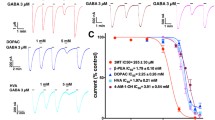Abstract
Rationale
In vitro studies have identified a series of decahydroisoquinoline compounds with differential selectivity for the subunits that comprise AMPA/kainic acid receptors. Compounds have been identified that have preferential activity at AMPA receptors (LY302679), whereas others (LY377770) have affinity for GluR5-kainic acid preferring subunit, which is activated by ATPA and kainic acid.
Objectives
These studies set out to determine if locomotor activity could differentiate these profiles in vivo.
Methods
Locomotor activity was assessed in photocell drums in male Lister Hooded rats.
Results
AMPA, kainic acid and the GluR5 selective agonist ATPA, all suppressed spontaneous locomotor activity (SLA) in rats at doses of 1.0, 5.0 and 20 mg/kg resp. All three agonists achieve micromolar concentrations measured in whole brain after dosing with 10 mg/kg SC. The decahydroisoquinoline antagonist compounds, LY302679 (GluR2), LY293558 (GluR2, 5) and LY377770 (GluR5) all decreased SLA in rats (EDmin 2.5, 5.0 and 20 mg/kg respectively). The rank order of potency at GluR2 subunits (LY302679>LY293558>LY377770) was reflected in the same rank order of activity for suppression of SLA. LY293558 reversed the suppression of SLA induced by all three agonists (0.62–2.5 mg/kg). LY377770 reversed the effects of ATPA only (EDmin 1.0 mg/kg), LY302679 (EDmin 2.5 mg/kg) attenuated the effect of kainic acid but was ineffective against AMPA and ATPA.
Conclusions
Both agonist and antagonist suppression of SLA is associated with greater affinity for the GluR2 subunit, while compounds with affinity for the GluR5 subunit were less potent in suppressing SLA.





Similar content being viewed by others
References
Arnt J, Sanchez C, Moltzen Lenz S, Madsen U, Krogsgaard-Larsen P (1995) Differentiation of in vivo effects of AMPA and NMDA receptor ligands using drug discrimination methods and convulsant/anticonvulsant activity. Eur J Pharmacol 285:289–297
Benvenga MJ, Ornstein PL, Leander JD (1995) Schedule-controlled behavioral effects of the selective 2-amino-3-(5-methyl-3-hydroxyisoxazol-4-yl-propanoic acid antagonist LY293558 in pigeons. J Pharmacol Exp Ther 275:164–170
Bleakman D, Schoepp D, Ballyk B, Bufton H, Sharpe EF, Thomas K, Ornstein PL, Kamboj RK (1996) Pharmacological discrimination of GluR5 and GluR6 kainate receptor subytpes by (3S,4aR,6R,8aR)-6-[2-(1(2)H-tetrazole-5-yl)ethyl] decahydydroisoquinoline-3 carboxylic acid. Mol Pharmacol 49:581–585
Burnashev N (1995) Molecular mechanisms controlling calcium entry through AMPA-type glutamate receptor channels. Neuron 25:987–990
Chittajallu R, Braithwaite SP, Clarke VRJ, Henley SJ (1999) Kainate receptors: subunits, synaptic localization and function. Trends Pharmacol Sci 20:26–35
Clarke VRJ, Ballyk BA, Hoo KH, Mandelzys A, Pellizari A, Bat CP, Thomas J, Sharpe EF, Davies CH, Ornstein PL, Schoepp DD, Kamboj RK, Collingridge GL, Lodge D, Bleakman D (1997) A GluR5 kainate receptor that regulates inhibitory synaptic transmission in the hippocampus. Nature 389:599–603
Danysz W, Parsons C (1998) Glycine and N-methyl-d-aspartate receptors: physiological significance and possible therapeutic applications. Pharmacol Rev 50:597–664
Danysz W, Essman U, Bresink I, Wilke R (1994) Glutamate antagonists have differential effects on spontaneous locomotor activity in rats. Pharmacol Biochem Behav 48:111–118
Dingledine R, Borge K, Bowie D, Traynelis SF (1999) The glutamate receptor ion channels. Pharmacol Rev 51:7–61
Lauridsen J, Honore T, Krogsgaard-Larsen P (1985) Ibotenic acids analogues synthesis, molecular flexibility and in vitro activity of agonists and antagonists at central glutamic acid receptors. J Med Chem 28:668–672
Maj J, Rogoz Z, Skuza G, Jaros T (1995) Some behavioral effects of CNQX and NBQX, AMPA receptor antagonists. Pol J Pharmacol 47:269–277
O’Neill MJ, Bond A, Ornstein PL, Ward MA, Hicks CA, Hoo K, Bleakman D, Lodge D (1998) Decahydroisoquinolines: novel competitive AMPA/kainate antagonists with neuroprotective effects in global cerebral ischemia. Neuropharmacology 37:1211–1222
O’Neill MJ, Bogaert L, Hicks CA, Bond A, Ward MA, Ebinger G, Ornstein PL, Michotte Y, Lodge D (2000) LY377770, a novel iGlu5 kainate receptor antagonist with neuroprotective effects in global and focal ischemia. Neuropharmacology 39:1575–1588
Ornstein PL, Arnold, MB, Augenstein NK, Lodge D, Leander JD, Schoepp DD (1993) (3SR, 4aRS, 6RS, 8aRS)-6-(2-(1H-Tetrazol-5-yl)ethyl-] decahydroisoquinoline-3-carboxylic acid: a structurally novel, systemically active, competitive AMPA receptor antagonist. J Med Chem 36:2046–2048
Ornstein PL, Arnold MB, Allen NK, Bleisch T, Borromeo PS, Lugar CW, Leander JD, Lodge D, Schoepp DD (1996) Structure-activity studies of 6-substituted decahydroisoquinoline-3-carboxylic acid AMPA receptor antagonists. 2. Effects of distal acid biosteric substitution, absolute stereochemical preferences, and in vivo activity. J Med Chem 39:2232–2244
Otis T, Zhang S, Trussell LO (1996) Direct measurement of AMPA receptor desensitization induced by glutamatergic synaptic transmission. J Neurosci 16:7496–7504
Royle SJ, Collins FC, Rupniak HT, Barnes JC, Anderson R (1999) Behavioural analysis and susceptibility to CNS injury of four inbred strains of mice. Brain Res 816:337–349
Schoepp DD, Gamble AY, Salhoff CR, Johnson BG, Ornstein PL (1990) Excitatory amino acid-induced convulsions in neonatal rats mediated by distinct receptor subtypes. Eur J Pharmacol 182:421–427
Seeburg PH (1993) The molecular biology of mammalian glutamate receptor channels. Trends Pharmacol Sci 14:297–303
Sperk G, Lassmann H, Baran H, Kish SJ, Seitelberger F, Hornykiewicz O (1983) Kainic acid induced seizures: neurochemical and histopathological changes. Neuroscience 10:1301–1315
Wilding TJ, Huettner JE (1996) Antagonist pharmacology of kainate- and alpha-amino-3-hydroxy-5-methyl-isoxazolepropionic acid-preferring receptors. Mol Pharmacol 49:540–546
Author information
Authors and Affiliations
Corresponding author
Rights and permissions
About this article
Cite this article
O’Neill, M.F., Sanger, G., Ornstein, P.L. et al. Locomotor activity detects subunit-selective effects of agonists and decahydroisoquinoline antagonists at AMPA/kainic acid ionotropic glutamate receptors in adult rats. Psychopharmacology 179, 181–188 (2005). https://doi.org/10.1007/s00213-004-2055-8
Received:
Accepted:
Published:
Issue Date:
DOI: https://doi.org/10.1007/s00213-004-2055-8




